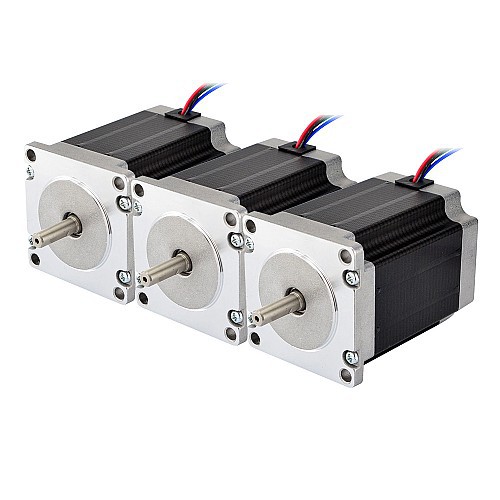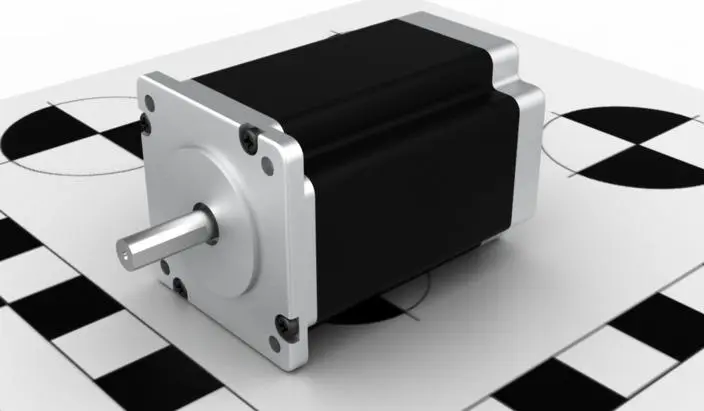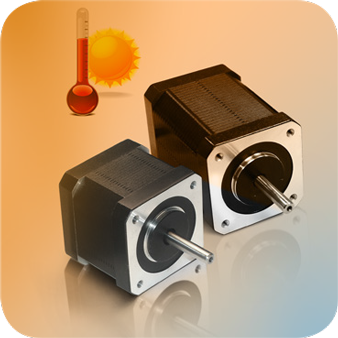-
The Role of Stepper Motor Inductance and Selection Considerations
05/11/2024 at 07:20 • 0 commentsStepper motor inductance is a crucial parameter that influences motor performance. Its primary functions are as follows:
1. Energy Storage
When voltage is applied to the motor, the inductance stores energy, generating a magnetic field. Upon voltage removal, the inductance releases energy, sustaining the magnetic field's decay for a period.
- Limiting Current Change Rate
- Impacting Motor Response Speed
- Influencing Motor Heat Generation
Inductance impedes abrupt current changes. According to Lenz's law, when current changes, the inductance generates a counter-electromotive force (CEMF) that opposes the current change. This is essential for stepper motor control as the motor requires rapid current direction changes to achieve stepping motion.
Inductance reduces the motor's response speed to control signals. This is because the inductance takes time to store and release energy. For high-speed applications, choose motors with lower inductance to enhance response speed.
Inductance increases the motor's copper losses, leading to heat generation. Therefore, consider inductance value and ambient temperature when selecting motors to prevent overheating and damage.
![]()
How to Select Proper Stepper Motor Inductance
Stepper motor inductance selection involves considering several factors:
1. Motor Speed
For high-speed applications, choose motors with lower inductance to improve response speed.
- Motor Load
- Ambient Temperature
- Control Method
For heavier loads, select motors with higher inductance to achieve greater torque.
For high ambient temperatures, choose motors with lower inductance to reduce heat generation.
For control methods requiring rapid current direction changes, select motors with lower inductance.
Generally, stepper motors with inductance values between 0.5mH and 5mH are suitable for most applications. If you have any questions regarding inductance value selection, consult the motor manufacturer or the motor driver's technical support.
Summary
Stepper motor inductance is a critical parameter affecting motor performance. Choosing the appropriate inductance value is essential for ensuring proper motor operation. When selecting inductance, consider factors such as motor speed, load, ambient temperature, and control method.
-
How to Choose the Right Stepper Motor Based on Resistance?
05/11/2024 at 07:19 • 0 commentsThe resistance value of astepper motor has a significant impact on its performance, including current, heat generation, torque, and speed. Therefore, selecting the appropriate resistance value is crucial. Here are some principles to consider when selecting resistors for stepper motors:
1. Determine the Appropriate Resistance Value Based on Motor Voltage and Current
The resistance value of a stepper motor can be calculated using the following formula:
R = U / I
Where:
R: Resistance value (unit: ohm)
U: Motor voltage (unit: volt)
I: Motor current (unit: ampere)
When selecting the resistance value, ensure that the motor current does not exceed its rated current. Otherwise, the motor may overheat and damage.
![]()
2. Determine the Appropriate Resistance Value Based on Motor Torque and Speed Requirements
The relationship between motor torque and speed with the resistance value is as follows:
Torque is directly proportional to current and inversely proportional to resistance.
Speed is directly proportional to voltage and inversely proportional to resistance.
Therefore, for applications requiring higher torque, choose a smaller resistance value. For applications requiring higher speed, choose a larger resistance value.
3. Consider the Motor's Heat Resistance
A lower resistance value leads to higher motor current and increased heat generation. Therefore, consider the motor's heat resistance when selecting the resistance value to prevent overheating and damage.
Specific Selection Recommendations:
For low-speed, high-torque applications, choose a stepper motor with a higher resistance value.
For high-speed, low-torque applications, choose a stepper motor with a lower resistance value.
For applications requiring frequent starting and stopping, choose a stepper motor with a lower resistance value.
For high-temperature environments, choose a stepper motor with better heat resistance.
In practical applications, consider the specific application requirements and select the appropriate stepper motor resistance value based on the factors mentioned above.
-
Why Do Stepper Motors Lose Steps When They Get Hot?
04/11/2024 at 03:06 • 0 commentsWhen a stepper motor gets hot, it loses steps and fails to rotate. Under no-load conditions, the following may be the reasons:
- Excessive load or stuck: If the motor load is too large or the motor bearings are stuck, it will cause the motor controller to continuously output current, causing the motor to overheat, and it will easily lead to loss of steps and the motor not rotating.
- Drive circuit problems: Unreasonable drive circuit design or unstable drive voltage will cause the motor to heat up and affect its normal operation.
- Poor heat dissipation of the motor shell: When working in a high temperature environment for a long time, poor heat dissipation of the motor will cause the motor temperature to be too high and easily damage the motor.
- The stepper motor generates serious heat: The stepper motor itself generates a certain amount of heat due to its working principle. However, if the motor heats up severely, there may be a problem with the motor's internal windings or iron core, which requires inspection and repair.
![]()
To solve this problem, the following measures can be taken:
- Check the load: Make sure the motor load is within the normal range to avoid overload or underload. At the same time, check whether the motor bearings are normal. If any abnormalities are found, they need to be replaced in time.
- Check the drive circuit: Make sure the drive circuit design is reasonable and the drive voltage is stable. If there is a problem with the drive circuit, it needs to be repaired or replaced in time.
- Optimize heat dissipation: Ensure that the motor casing has good heat dissipation conditions. You can install heat sinks or fans and other heat dissipation equipment on the motor casing to help the motor dissipate heat quickly.
- Check the motor: If the motor heats up severely or other abnormalities occur, the motor needs to be inspected, repaired or replaced in time.
My Pages
Projects I Like & Follow
Share this profile
ShareBits
Become a Hackaday.io Member
Create an account to leave a comment. Already have an account? Log In.



 Lutetium
Lutetium niftylight
niftylight Frederic
Frederic Hari Wiguna
Hari Wiguna Mike Szczys
Mike Szczys Makarand Kapoor
Makarand Kapoor Philip Zucker
Philip Zucker David Prutchi
David Prutchi Rodolfo
Rodolfo Marius Heier
Marius Heier jon.knutton
jon.knutton Brian Brocken
Brian Brocken Celestial Robotics
Celestial Robotics Greg Zumwalt
Greg Zumwalt engineerkid1
engineerkid1